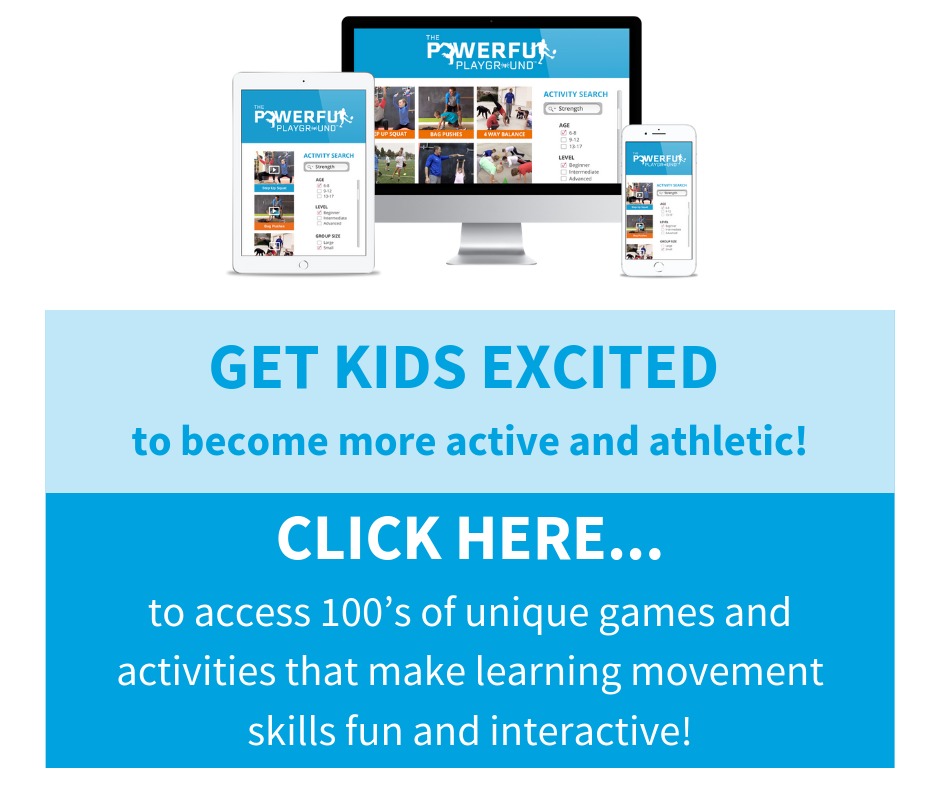The #1 question we receive at SPIDERfit Kids is…
How do I start a youth fitness program in my community?
In my nearly 25 years of experience in the youth fitness industry, I have worked for youth sports and fitness programs all across the US. Most recently, I started and directed the youth athletic and fitness program at Todd Durkin’s Fitness Quest 10 in San Diego, CA.
After 15 years of growing that program to impact hundreds, sometimes thousands, of kids each week, I have committed my time and energy to educating fitness professionals around the world how to do the same.
 While I would like to say, “Just do (x), and you’ll have a successful program in no time,” it’s just not that simple. The real answer to the “how” question comes in the form of trial and error, blood, guts, and sweat, long hours, relentless dedication and passion, and much more. However, by taking some tried and true tangible steps, you can put your path to creating a successful youth program on a fast track.
While I would like to say, “Just do (x), and you’ll have a successful program in no time,” it’s just not that simple. The real answer to the “how” question comes in the form of trial and error, blood, guts, and sweat, long hours, relentless dedication and passion, and much more. However, by taking some tried and true tangible steps, you can put your path to creating a successful youth program on a fast track.
Below are 5 steps that I identified early in my career that continue to help myself and others create successful youth programs that positively impact their community. It’s important to note that these steps begin with the assumption you have acquired appropriate education, certification, and experience to be working with children.
Step 1: Be Engaged in Your Community
If you want to offer a service for youth in your community, get involved with the youth! Initially, this could entail volunteering at schools, sports organizations, or other youth-based community programs.
This not only helps in acquiring much-needed experience, it allows you to truly understand the expressed needs within your community. Listen to parents, coaches, teachers, and other youth influencers in your area.
- Are they asking for your service?
- Do they value programs like the one you would like to create?
- What would they value in that program?
- What time, location, price point would be most appropriate?
- What barriers would exist to them bringing their kids to your program?
- Can you help eliminate these barriers?
- Who is currently offering a service similar to the one you would like to?
- Is that business thriving?
While you may not be able to get point-blank answers to these questions, the more you are involved like a parent, teacher, or coach in your community, the more you will understand their needs.
Too many coaches create programs based on what they want and value, not what their community does. The result is consistent frustration.
 Another advantage to getting involved with the youth in your community is that it’s an opportunity to associate you and your brand with being a trusted coach to work with kids. Parents can be weary to send their child to work with a stranger, especially when they aren’t working for a larger company. Quality face time with kids and families in your community establishes you as a trusted, safe, and valuable asset for their children’s development.
Another advantage to getting involved with the youth in your community is that it’s an opportunity to associate you and your brand with being a trusted coach to work with kids. Parents can be weary to send their child to work with a stranger, especially when they aren’t working for a larger company. Quality face time with kids and families in your community establishes you as a trusted, safe, and valuable asset for their children’s development.
Once you’ve determined what your community needs, and your vision of how you plan to fulfill that need, it’s time to get your administrative ducks in a row.
While this is absolutely the least enjoyable aspect of creating a youth program (or any business venture for that matter), it’s a critical step towards success. Plain and simple, ignoring the business and administrative aspects of starting a program is the #1 reason youth programs fail. Before you start announcing your program to the community, make sure you can answer the questions below:
- Where will the program be held? Many local parks now require a license or permit to conduct a business there. If you will be renting/sharing space with a local gym, make sure to understand their clientele and make sure they understand your needs as well. Few things are more headache-inducing than a sour business relationship.
 If your vision involves purchasing a space, consider that an overwhelming majority of kids will only be available for your program between the hours of about 3 and 7 pm. Unless you can share space with another business outside of these hours, you must consider how you will be able to cover your expenses and be profitable when kids are not training.
If your vision involves purchasing a space, consider that an overwhelming majority of kids will only be available for your program between the hours of about 3 and 7 pm. Unless you can share space with another business outside of these hours, you must consider how you will be able to cover your expenses and be profitable when kids are not training.
- Do you have insurance? In these litigious times, it’s essential that you have some sort of professional liability insurance. Luckily, most certifying agencies offer professional liability insurance for reasonable rates. Protect yourself so you can continue to help people for years to come.
- What will the program cost? Consider what others in your area charge for services similar to yours. Coming in as the “cheapest” is not advised. Plan on introducing and continuing to create tremendous value. If you consider a premium price point, make sure you are confident you can establish this value quickly with parents that are willing to pay. Unless you’re a not-for-profit funded by something other than registration, long-term “free” programs fail.
For one, the market has demonstrated time and time again that adherence to a free program is almost zero. Participants usually need skin in the game. Even more importantly, you must ask yourself if a program requiring a large share of your time, energy, and yes, money, is sustainable for you if it doesn’t accommodate your survival needs.
It’s critical to understand the ongoing expenses associated with your program. How much or your total time does it occupy per week? Not just during the program, but set up, preparation, transportation to the location, etc.
With your intended registration fees, how many kids will need to register in order for your program to be both profitable and sustainable? Have programs similar to yours accomplished these numbers in your community?
- Where will parents go to find out details and information about your program?
An elaborate and expensive website isn’t necessary to educate parents about your program. However, there should be somewhere (simple website, Facebook page) that can serve as an online “home base” for people in your community to learn about your story and how your program will help them accomplish their goals as a parent.
While there are many other administrative steps that must occur, these are some of the most critical.
Step 3: Establish Yourself as the Expert for Working with Youth
Once your program has begun (and preferably before) continually work to be recognized as an expert in working with youth. Parents are willing to go through more barriers to have their kids work with an expert.
Step 1 above is critical in establishing a platform from which you can educate your community. Make sure you look for opportunities to speak at local events on youth fitness topics relevant to the parents, coaches, and teachers in your community. Use social media tools to post short, relevant, and valuable content.

Consider the biggest problem your community has expressed in regard to their youth, then continually work to provide solutions. What are their most frequently asked questions? Answer them. What are their biggest fears for their kids? Ease their fears. Where do they go for trusted information? Be there with your message!
Positioning yourself as an expert is an on-going process. Always be looking for opportunities to use your knowledge and experience to help kids and parents in a relevant way!
Step 4: Create Unique Value
Why should a parent bring their child to your program? How does your program compare to others? If you want to make unprecedented impact on the youth in your community, you have to continue to create unprecedented value to both kids and parents!
What do parents, teachers, and coaches value in your community? How do you shape your program to accommodate this at a level where kids and parents become raving fans?

Most youth fitness programs are led by a coach who is certified and has at least some education/experience working with kids. The program is located at a park or gym. After 60 minutes of activities and a finishing pep talk, kids go home. While this can be a very valuable experience, how are you going prove that you are more and different than your competition?
- Can you remove parental barriers to bringing their kids? For example, instead of the 60-minute model, can you become part of an after school care program? In this model, the fitness piece could be part of a larger program that encompasses homework help and other services parents value.
- Through your program, can you inspire kids to do things that their parents can’t get them to do? For example, do you incorporate incentives for things like making their bed, cleaning their room, eating their vegetables, etc.?
- Does your program demonstrate some sort of pedagogy for advancement? Consider the martial arts class model. Kids come to learn specific skills to progress to a recognized benchmark (a colored belt). This is a huge adherence booster.
Consider other ways your program could differ from the standard youth fitness class model.
Step 5: Continue to Grow Relationships
When you offer a service within your community, your job engaging with that community is never done. At least once per week, you should be reaching out to parents and kids within yours and surrounding communities to expand your impact.
- Contact at least one local sports organization per week and offer demonstrations of your program
- Contact every teacher of every child in your program and offer a one-page, bulleted synopsis of what your program accomplishes and how it helps the teachers’ goals with kids
- Contact every sports coach of every child in your program personally and open a dialogue about their young athlete. Serve as a resource for these coaches whether they currently are doing team programs with your organization, or not
- Consider how you could become involved with state and national initiatives for youth related causes
While there are thousands of more steps (forward and backward!) to creating a successful program, beginning with these 5 will help shorten the path between starting your program and inspiring kids to become active and athletic for life!

Brett Klika CEO and co-founder of SPIDERfit is an international award- winning certified strength and conditioning coach, author, and motivational speaker with over 20 years experience motivating and inspiring youngsters to a life of health, fitness, and performance.
Brett consults with schools, athletic organizations, fitness professionals, and fortune 500 companies around the world.





Connect with SPIDERfit!